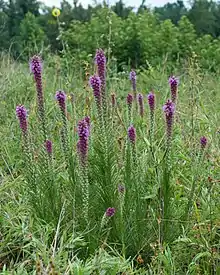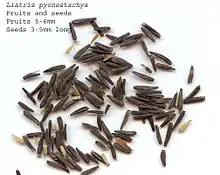Liatris pycnostachya
Liatris pycnostachya, the prairie blazing star or cattail blazing star,[1] is a perennial plant native to the tallgrass prairies of the central United States.[2][3]
| Liatris pycnostachya | |
|---|---|
 | |
| Scientific classification | |
| Kingdom: | Plantae |
| Clade: | Tracheophytes |
| Clade: | Angiosperms |
| Clade: | Eudicots |
| Clade: | Asterids |
| Order: | Asterales |
| Family: | Asteraceae |
| Genus: | Liatris |
| Species: | L. pycnostachya |
| Binomial name | |
| Liatris pycnostachya Michx. | |
The flower stalks reach 60 to 120 cm (2 to 4 ft) in height, or rarely to 180 cm (6 ft). The leaves are linear, grass-like, 11 to 22 cm (4 1⁄4 to 8 3⁄4 in) long and 4 to 10 mm (0.16 to 0.39 in) wide.[1] They grow both from the root and in great numbers on the flower stems, becoming progressively smaller higher up the stem. The end of the flower stem is covered in a spike of flower heads 1⁄4 to 1⁄2 in (6 to 13 mm) across that bloom pink to purplish pink for a month in late summer,[4] from the top down.[5] Each flower head has 5 to 8 florets[1] and is surrounded by overlapping pinkish bracts (phyllaries) whose tips are pointed and curve backwards.[5] The stems, leaves, and bracts may be smooth or hairy to varying degrees.[1][6] The shape of the bracts distinguishes this species from others, for example Liatris spicata, another tall Liatris species that has thickly packed spikes, but whose bracts are flat with rounded tips.[7][8]
The root system is a corm that sometimes develops into a rhizome.[1] It produces offsets and gradually forms a clump.
The species epithet comes from Ancient Greek πυκνός (puknós) "dense" and στάχυς (stákhus) "ear of grain",[9] referring to the thickly packed spike of flowers.
It is a larval host to the bleeding flower moth (Schinia sanguinea).[10]

References
- Nesom, Guy L. (2006). "Liatris pycnostachya". In Flora of North America Editorial Committee (ed.). Flora of North America North of Mexico (FNA). 21. New York and Oxford – via eFloras.org, Missouri Botanical Garden, St. Louis, MO & Harvard University Herbaria, Cambridge, MA.
- "Liatris pycnostachya". County-level distribution map from the North American Plant Atlas (NAPA). Biota of North America Program (BONAP). 2014.
- Pink, A. (2004). Gardening for the Million. Project Gutenberg Literary Archive Foundation.
- Hilty, John (2016). "Prairie Blazingstar (Liatris pycnostachya)". Illinois Wildflowers. Retrieved July 17, 2018.
- Chayka, Katy; Dziuk, Peter (2016). "Liatris pycnostachya (Prairie Blazing Star)". Minnesota Wildflowers. Retrieved July 17, 2018.
- "Liatris pycnostachya". Native Plant Database. Lady Bird Johnson Wildflower Center, University of Texas at Austin.
- Hilty, John (2016). "Marsh Blazingstar (Liatris spicata)". Illinois Wildflowers. Retrieved July 17, 2018.
- Nesom, Guy L. (2006). "Liatris spicata". In Flora of North America Editorial Committee (ed.). Flora of North America North of Mexico (FNA). 21. New York and Oxford – via eFloras.org, Missouri Botanical Garden, St. Louis, MO & Harvard University Herbaria, Cambridge, MA.
- πυκνός and στάχυς. Liddell, Henry George; Scott, Robert; A Greek–English Lexicon at the Perseus Project
- The Xerces Society (2016), Gardening for Butterflies: How You Can Attract and Protect Beautiful, Beneficial Insects, Timber Press.
External links
| Wikimedia Commons has media related to Liatris pycnostachya. |